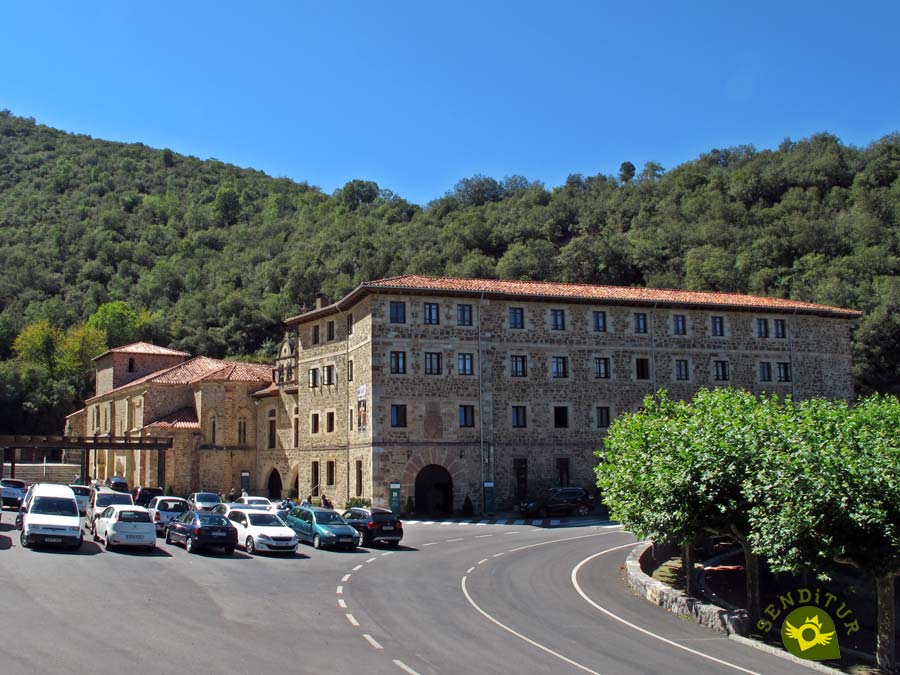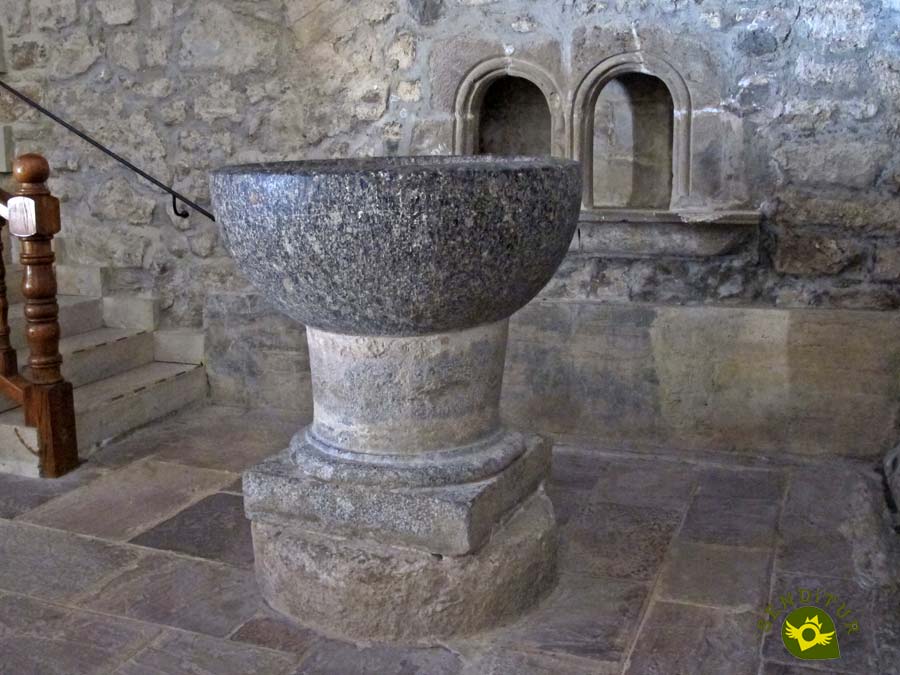Monastery of Santo Toribio de Liébana
Guardian and custodian of the Lignum Crucis
Guardian and custodian of the Lignum Crucis
It is a desired destination for the pilgrim who undertakes the Lebaniego Way, is located in the foothills of the Picos de Europa, on the northern slope of Mount La Viorna, about two kilometers from Potes, in the region of Liébana. The origin of the monastery is not very clear but everything seems to indicate that its founder was Santo Toribio, bishop of Palencia, in the sixth century, who decided to retire to this place with a group of monks to live according to the Benedictine rule. The Monastery of Santo Toribio de Liébana was originally dedicated to San Martín de Turieno. In it, the monk Beato of Liébana in the 8th century wrote and illustrated his books. The monastery was donated by Alfonso VIII to Counts Don Gómez and Doña Emilia, who later ceded it to the Monastery of San Salvador de Oña, along with other possessions.

It is believed that in the mid-eighth century, and to protect them from the Muslim attack, the mortal remains of Santo Toribio, bishop of Astorga, were brought here along with some of the relics that this saint had brought from the Holy Land, including the Lignum Crucis that is venerated in this holy place. The first reference to the Monastery of Turieno, with the name of Santo Toribio de Liébana dates from the year 1125. The monastery, which soon became a religious and cultural centre, a place of pilgrimage with a recognised Jubilee Year, was inhabited by Benedictine monks until 1837 when, due to the disentailment of Mendizábal, they had to abandon it. Today, since 1961, it is a community of Franciscan monks who live and care for the Monastery of Santo Toribio de Liébana.

The most important and only building that remains, with various reforms and remodeling, of the Monastery of Santo Toribio de Liébana, one of the oldest in the region, is the church, built in the thirteenth century on a pre-Romanesque and Romanesque temple, following the rules of a Cistercian Gothic. In the south façade are opened its two doors, the main door in marked Romanesque style, and the most famous and important, the Door of Forgiveness that could be built later, in the fifteenth or early sixteenth century, and that only opens for access of faithful and pilgrims during the Jubilee Holy Year, that is, when the feast of Santo Toribio, April 16, falls on Sunday. Inside the church, a lateral baroque chapel from the 18th century houses and guards the Lignum Crucis, a relic that is placed in a beautiful gilded wooden temple. You can also visit the cloister of the monastery that was completed in the seventeenth century and currently hosts various exhibitions on the Commentaries of the Apocalypse, on the background of the Jubilee Year Lebaniego ... At the entrance to the cloister there is a modern relief depicting the figure of the Blessed of Liébana in his "scriptorium", this monk was abbot of the monastery and was largely dedicated to fighting heresy. Around 786 Beatus wrote his Commentaries on the Apocalypse of San Juan, a prophetic-type book that is canonical in the Bible and that explains the events that will take place at the end of the world.

In the surroundings of the monastery there are a good number of hermitages, the one of San Miguel, the one of Santa Catalina, both of century XIII, the Holy Cave, pre-Romanesque and semirrupestre, is the oldest of all and according to the tradition it was the place of retreat of Santo Toribio, the ruins of Nuestra Señora de los Angeles or those of San Pedro. As the Monastery of Santo Toribio is an important and emblematic place of pilgrimage, it is reached by several hiking routes. North, south, east and west converge in Santo Toribio, paths from different towns run through natural environments of beautiful landscapes. Now the road par excellence that has its destination in the Monastery of Santo Toribio is the one that make the numerous crucenos, so they are called to those who peregrinate to Santo Toribio to venerate the Cross. The Lebaniego Way, with its own credential and obtaining, at the end, the Lebaniega, starts in the town of San Vicente de la Barquera and for three stages, the crucenos, run this way that ends in full Picos de Europa and has been declared by UNESCO in the year 2015 World Heritage to have been included in the itineraries of the Way of Saint James next to the Primitive Way, the North Way and the Basque Way of the Interior. From Potes and through the Vadiniense Way, which starts here, the Lebaniego Way can be joined, in Mansilla de las Mulas, with the French Way of Saint James.

Pope Julius II granted the Monastery of Santo Toribio de Liébana the privilege of celebrating the Jubilee Year, traditionally celebrated every 100 years, in later times and until today is celebrated whenever the feast of Santo Toribio, April 16, falls on a Sunday. The Lebaniego Holy Year begins on Sunday 16 April and the Door of Forgiveness remains open all year round. Already in the 12th century the first brotherhood of all Christianity was created, the Brotherhood of the Holy Cross of Santo Toribio de Liébana, and the importance of this monastery has always been such that the kings of Castilla and Aragón granted their monks permission to travel around Spain begging for alms to support the monastery and its pilgrim hospital.

The Monastery of Santo Toribio de Liébana has, together with Jerusalem, Rome, Santiago de Compostela and Caravaca de la Cruz, the privilege of celebrating the Holy Year. This privilege was granted in 1512 by means of a bull of Pope Julius II. The Sacred Log that is kept in the monastery seems to be a piece of the left arm of the Cross of Christ and could correspond to the one left in Jerusalem back in the fourth century, Elena, the mother of Emperor Constantine. This relic, sawn and put in cross mode but keeping the whole hole where they nailed the hand of Jesus, with measures of 635 mm the vertical stick and 393 mm the crossbar and with a thickness of 38 mm and protected by a silver cross gilded, is the largest preserved of the cross of Christ.


There are several legends heard about the foundation of the monastery, one of them, whose protagonists are represented in the central apse of the church, bear and ox, says that when Santo Toribio de Palencia came to these places with the idea of raising a monastery and working in the Christianization of the inhabitants of the place, he walked through the forest looking for the best place for his location when he saw how a bear and an ox were engaged in a fierce struggle, then the saint approached them and with his words he managed not only to separate them but also that together and in unison they helped him in the construction of the monastery. When this was resolved, he had to find the right place and then Saint Toribio, throwing his staff, said: Where my staff falls, I will build my dwelling.
MORE ROUTES AVAILABLE, DON'T MISS IT...
MORE PLACES AVAILABLE, DON'T MISS IT...
The Monastery of Santo Toribio de Liébana is reached by a detour on the CA-185 road leaving Potes in the direction of Fuente Dé. Potes has a regular bus service that daily connects it with Santander and the towns along the route.
There are ample parking areas where you can leave your vehicle.
SENDITUR is not responsible for any variation in the information described, as well as for the misuse of its guides and recommends that everyone be responsible and prudent in carrying out the activity. Likewise, we invite you to document yourself with books and specialized guides to complement the information described. From the commitment of SENDITUR with Nature and the respect to the balance of the environment, SENDITUR urges you to travel in a responsible way, with low environmental impact and respecting at all times the Natural, Cultural and Social environment wherever you go. For any suggestion, SENDITUR invites you to send an email to
Continue watching …